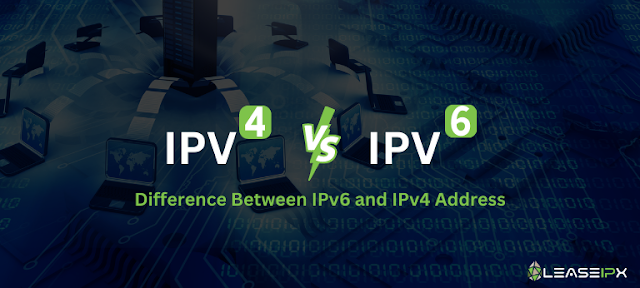What is the Difference Between IPv6 and IPv4 Address?
Want to know the difference between IPv6 and IPv4 address? You've landed on the right page. We are going to cover what IPv4 and IPv6 addresses are, their features and the differences between them. Continue reading to learn all about IPv6 and IPv4 addresses.
What is IPv4?
IPv4 (Internet Protocol version 4) is the fourth version of the Internet Protocol (IP), a protocol used to identify and communicate with Internet-connected devices. IPv4 is the most frequently used Internet protocol, and it is used to issue unique numerical addresses, known as IP addresses, to all devices connected to the Internet.
An IPv4 Address is a 32-bit number that is commonly represented in decimal format with four sets of integers ranging from 0 to 255 separated by periods, for example, 192.0.2.1. IPv4 supports up to 4.3 billion distinct addresses, which has become a constraint since the number of devices and Internet users has expanded tremendously in recent years.
Features of IPv4 Address
The following are the features of IPv4 addresses:
Datagram Protocol: IPv4 runs at the network layer of the OSI model and sends packets between hosts using a connectionless datagram protocol.
Fragmentation: To accommodate differing network settings and packet sizes, IPv4 packets can be divided into smaller pieces.
Header Format: The IPv4 header contains data such as version, header length, kind of service, time to live, protocol, source and destination IP addresses, and header checksum.
Routing: IPv4 uses multiple routing protocols, including static routing and dynamic routing protocols like OSPF and BGP, to find the optimal path for packets to take to their destination.
What is IPv6?
IPv6 (Internet Protocol version 6) is the most recent version of the Internet Protocol (IP) that is intended to replace IPv4. The major purpose of IPv6 is to give more address space than IPv4, which is becoming increasingly scarce as the Internet grows and connected devices proliferate.
IPv6 addresses are 128 bits long, allowing for about 3.41038 unique addresses. IPv6 addresses are commonly written in hexadecimal notation and separated by colons, for example, 2001:0db8:85a3:0000:0000:8a2e:0370:7334.
IPv6 contains numerous improvements and features over IPv4, such as a streamlined header format, greater support for Quality of Service (QoS), and improved security via built-in IPsec (Internet Protocol Security) support. However, the shift to IPv6 has been gradual due to the vast installed base of IPv4 infrastructure and devices, and many networks continue to utilize IPv4 alongside or instead of IPv6.
Features of IPv6
The following are the features of IPv4 addresses:
128-bit Addressing: IPv6 employs a 128-bit binary address to identify network and host interfaces, allowing for about 3.41038 unique addresses.
Multicast: IPv6 provides built-in support for multicast, which allows a single packet to be transmitted to several destinations at the same time.
Extension Headers: IPv6 supports extension headers, which can be used to insert additional information or processing instructions in the packet header.
Security: IPv6 contains built-in support for IPsec, which encrypts and authenticates IP packets.
Mobile IPv6: IPv6 has support for mobile devices, allowing them to maintain a stable IP address even as they travel across networks.
Address Length: The length of the addresses is the most noticeable variation. IPv4 addresses are 32 bits long and use dotted decimal notation (for example, 192.168.0.1), whereas IPv6 addresses are 128 bits long and use the hexadecimal notation (e.g., 2001:0db8:85a3:0000:0000:8a2e:0370:7334).
Address Space: IPv4 gives around 4.3 billion distinct addresses, which have essentially been depleted due to the Internet's fast expansion and device proliferation. In comparison, IPv6 provides around 3.4×10^38 unique addresses, which should be sufficient for future expansion.
Address Configuration: IPv4 addresses are often manually established by network administrators or provided dynamically via DHCP. IPv6 addresses can be configured automatically or manually using Stateless Address Autoconfiguration (SLAAC).
Network Address Translation (NAT): With IPv4, NAT is often used to allow numerous devices to share a single public IP address. Because the address space is large enough to provide unique addresses to every device, IPv6 does not require NAT.
Header Size: The IPv6 header is larger than the IPv4 header, but its structure is simpler, allowing for faster processing and more efficiency.
Extension Headers: IPv6 features extension headers, which allow for the inclusion of additional information and functionality in the packet header, whereas IPv4 has a set header structure.
Quality of Service (QoS): IPv6 supports QoS better than IPv4, allowing for more exact network traffic control and prioritization of specific types of traffic.
From IPv4 to IPv6: The Next Step
IPv6 is crucial to the future of the Internet. The Internet's address space will expand dramatically once the transition from IPv4 to IPv6 is complete. It's also important that each device can independently access the Internet without having to hide behind a NAT router. IPv4 and IPv6 currently coexist, but they were not created to work together. IPv4 may still exist for some time due to the cost and compatibility issues of IPv6, but IPv6 addresses will eventually be the norm.



%20(1200%20%C3%97%20800px).png)
Informative Content....Keep it up team!!
ReplyDelete